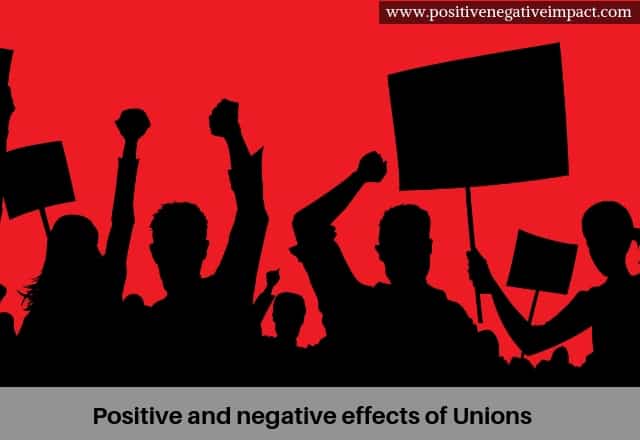One can surmise that with the advent of the industrialization, workers began to form into various groups with the sole aim of protecting worker rights. Thus the unions came into being, not by choice but by necessity. And even though various governments enacted laws to reduce and eliminate unions, they still managed to survive well into the 21st century. Today, you can find such unions in public sector companies, closely watching the management and going the extra mile to protect workers’ rights. But the unions have been single-handedly responsible for various positive outcomes as well as negative outcomes. This is why it is time that we took a closer look at some of the positive and negative aspects of unions.

Positive Effects of Unions
- Higher wages: Unions have been responsible for workers obtaining higher wages. Ever since the first strike, this has been the core demand of most unions, higher wages and fairer working conditions. While most of the management would find it hard to grant the Union’s request as far as the later request went, they often opted to increase wages incrementally. In 2010, according to the US Bureau of Labor statistics, unionized workers brought in $800 extra, more than non-unionized workers which make it apparent why it pays to belong to a union.
- Better benefits: Unionized workers often get better access to various benefits such as medical benefits, and get more leave and vacation days than non-unionized workers. A recent survey highlighted this anomaly which only makes the case for Unions. It is apparent that these unions take care of their members and as such, most unionized workers avail better benefits than their counterparts who are not unionized.
- Retirement fund: Most unionized workers have access to a retirement fund set up by the management. It could be a 401K or an IRA contribution plan and in a few cases, a pension plan or both. The Non-unionized workers have access to retirement funds courtesy their employer only 64% of the time. This makes it apparent that when it comes to retirement funds, unionized workers get better benefits than non-unionized workers.
- Job Security: Unlike Unionized workers, non-unionized workers are often hired at will and can be let go at any time without any repercussions. Unions protect workers’ rights, especially that of unionized labourers.
- Create better opportunities’: Unions help create better opportunities’ for the various workers so that they can negotiate better pay package in two to three years. It is up to each individual employee but essentially they can negotiate and even bargain so that they feel that they are getting paid their true worth.
Negative Aspects of Unions
- LIFO: LIFO or last in, first out seems to define the modern unions perfectly; for example, if the unions have agreed with the management regarding layoffs, then the most junior in the staff would be let go. Similarly, if there is a promotion in the wings, then the most senior person who had served on the job the longest would be offered the same. This may sound unfair, the process may even discount education but this is the process most Unions adopt.
- Union dues: it may seem unfair but even Unions require some funds to keep it operating smoothly. That’s why most unionized workers are required to donate about 1-1.5% of their salary as union dues. As to whether the Union in question really does anything remains open to question.
- Individuality: One of the first things that most Unions do is to junk out individuality, and no one is going to appreciate someone looking like a sore thumb either. When you are part of the union, you are expected to be part of the larger decision and support the movement wholeheartedly.
- Strikes: Some unions are known for being disruptive and cause more fracas as they go on a strike en masse while they want for the management to agree to their demands. While this is part and parcel of what a Union is all about, such behaviour happens to be getting all unions a negative rap.
These are some of the positive and negative effects of unions; most of the negative effects can be mitigated with little effort and some determination on your part.
- Tulip Mania – The Story of One of History’s Worst Financial Bubbles - May 15, 2022
- The True Story of Rapunzel - February 22, 2022
- The Blue Fugates: A Kentucky Family Born with Blue Skin - August 17, 2021
